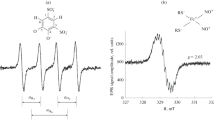Abstract
Liver microsomes and mitochondria and heart sarcosomes from rats fed diets with varying α-tocopherol concentrations and lipid contents were peroxidized over a 6 hr time period. Lipid peroxidation was measured by absorption of oxygen, production of thiobarbituric acid (TBA) reactants and by development of fluorescence. The spectral characteristics of the fluorescent compounds were the same for all peroxidizing systems; the excitation maximum was 360 nm and the emission maximum was 430 nm. As time of peroxidation increased, uptake of oxygen and production of fluorescent compounds increased. These two parameters as well as production of TBA reactants were dependent upon dietary antioxidant and all three had an inverse relationship with the amount of dietary α-tocopherol. The relationship between absorption of oxygen and development of fluorescent compounds was also dependent upon dietary polyunsaturated fats (PUFA). Subcellular particles from animals fed higher levels of PUFA produced more fluorescent products per mole of oxygen absorbed than did those from animals on a diet with lower PUFA content. TBA reacting products increased with time during the initial phase of peroxidation: in the microsomal systems their production stabilized or decreased by 4–6 hr of peroxidation. Using the synthetic 1-amino-3-iminopropene derivative of glycine as standard for quantitation of fluorescence, the molar ratios of oxygen absorbed per fluorescent compound produced were calculated. This ratio for subcellular particles isolated from rats fed diets with PUFA ratios similar to those in the average American human diet was 393∶1. The fluorescent compounds had the same spectral characteristics as the lipofuscin pigment that accumulates in animal tissues as a function of age, oxidative stress or antioxidant deficiency. The fluorescent molecular damage represented by that accumulated in human heart age pigment by 50 years of age was calculated to have been caused by approximately 0.6 μmole of free radicals per gram of heart tissue.
Similar content being viewed by others
References
Fleischer, S., and G. Rouser, JAOCS 43:588 (1965).
Tappel, A.L., and H. Zalkin, Arch. Biochem. Biophys. 80:326 (1959).
Tappel, A.L., Federation Proc. 24:73 (1965).
Kwon, T.W., and H.S. Olcott, J. Food Sci. 31:552 (1966).
Kwon, T.W., and H.S. Olcott, Nature 210:214 (1966).
Chio, K.S., and A.L. Tappel, Biochemistry 8:2827 (1969).
Chio, K.S., and A.L. Tappel, Ibid. 8:2821 (1969).
Chio, K.S., U. Reiss, B. Fletcher and A.L. Tappel, Science 166:1535 (1969).
Tappel, A.L., Amer. J. Clin. Nutr. 23:1137 (1970).
Tappel, A.L., Federation Proc., in press.
Packer, L., D.W. Deamer and R.L. Heath, Advan. Gerontol. Res. 2:77 (1967).
Tappel, A.L., Geriatrics 23:97 (1968).
Hartroft, W.S., in “Metabolism of Lipids as Related to Atherosclerosis,” Edited by F.A. Kummerow, Thomas, Springfield, Ill., 1965, p. 18.
Perkins, E.G., T.H. Joh and F.A. Kummerow, Ibid.“, p. 48.
Recknagel, R.O., Pharmacol. Rev. 19:145 (1967).
Di Luzio, N.R., and A.D. Hartman, Federation Proc. 26:1436 (1967).
Haugaard, N., Physiol. Rev. 48:311 (1968).
Draper, H.H., J.G. Bergan, M. Chiu, A.S. Csallany and A.V. Boaro, J. Nutr. 84:395 (1964).
Ragab, H., C. Beck, C. Dillard and A.L. Tappel, Biochim. Biophys. Acta 148:501 (1967).
Cleland, K.W., and E.C. Slater, Biochem. J. 53:547 (1953).
Miller, G.L., Anal. Chem. 31:964 (1969).
Wills, E.D., Biochem. J. 99:667 (1966).
Ernster, L., Acta Chem. Scand. 12:600 (1958).
Tappel, A.L., and B. Fletcher, Federation Proc. 29:783 abs (1970).
Hartroft, W.S., and E.A. Porta, in “Present Knowledge of Nutrition,” Third Edition, The Nutrition Foundation, New York, 1967, p. 41.
Porta, E.A., and W.S. Hartroft, in “Pigments in Pathology,” Edited by M. Wolman, Academic Press, New York, 1969, p. 191.
Wolman, M., “Handbuch der Histochemie,” Vol. 5, Gustav-Fischer Verlag, Stuttgart, 1964, p. 96.
Strehler, B.L., D.D. Mark, A.S. Mildvan and M.V. Gee, J. Gerontol. 14:430 (1959).
Reichel, W., J. Gerontol. 23:145 (1968).
Casarett, A.P., “Radiation Biology,” Prentice-Hall, Inc., New Jersey, 1968.
Author information
Authors and Affiliations
About this article
Cite this article
Dillard, C.J., Tappel, A.L. Fluorescent products of lipid peroxidation of mitochondria and microsomes. Lipids 6, 715–721 (1971). https://doi.org/10.1007/BF02531296
Received:
Issue Date:
DOI: https://doi.org/10.1007/BF02531296




